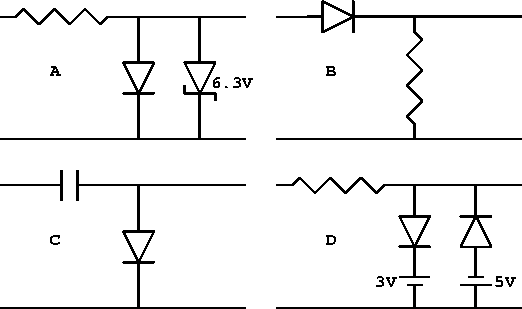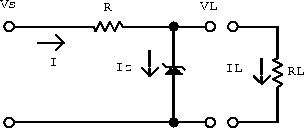- Make a sketch showing the current through an ideal diode as a function of the applied voltage. Also sketch the current through a real signal diode as a function of voltage.
- Make a sketch showing the current drawn through a Zener diode as
a function of the applied voltage. Show how to determine the
forward resistance (
 ), the reverse resistance (
), the reverse resistance (  ) and
the Zener resistance (
) and
the Zener resistance (  ) from your sketch. Label the
voltages
) from your sketch. Label the
voltages  and
and  .
.
- a 100 Hz sine wave with a peak voltage of 5 V, and
- a 100 Hz square wave with a peak-to-peak voltage of 10 V


- What is the voltage at terminal A in the above circuit?
- What is the current through the Zener? (What reasonable approximation makes this straightforward?).
- If the Zener is dissipating 1.0
 W (in heat), what can we
conclude to be the effective impedance of the diode for this
situation?
W (in heat), what can we
conclude to be the effective impedance of the diode for this
situation?
- Write down an equivalent linear-circuit model in the breakdown voltage region.
- Replace the Zener diode in the following voltage reference
circuit by your equivalent circuit model.

- Determine the contribution of the of Zener diode to this voltage reference circuit by calculating the elements of a Thevenin equivalent circuit representation.
- Show that for small Zener diode effective resistance the Thevenin equivalent voltage is close to the Zener breakdown voltage and thus is insensitive to changes in the source voltage.
- Show that for small Zener diode effective resistance, the Thevenin equivalent resistor gives the voltage source a reasonably small output impedance.
- The combined results show a voltage reference that is insensitive to voltage changes in the original EMF and to changes in the load current. State the assumptions under which this result is valid.